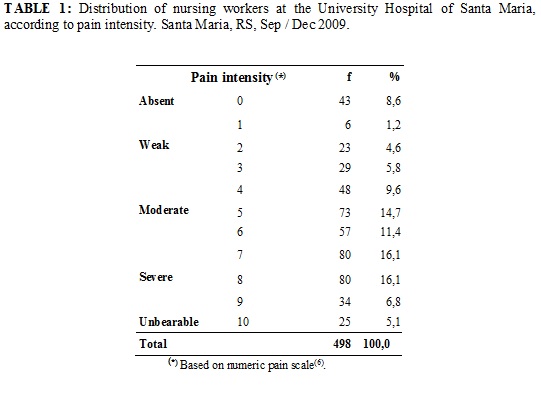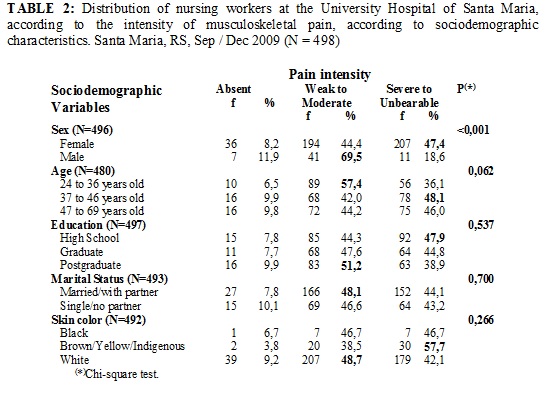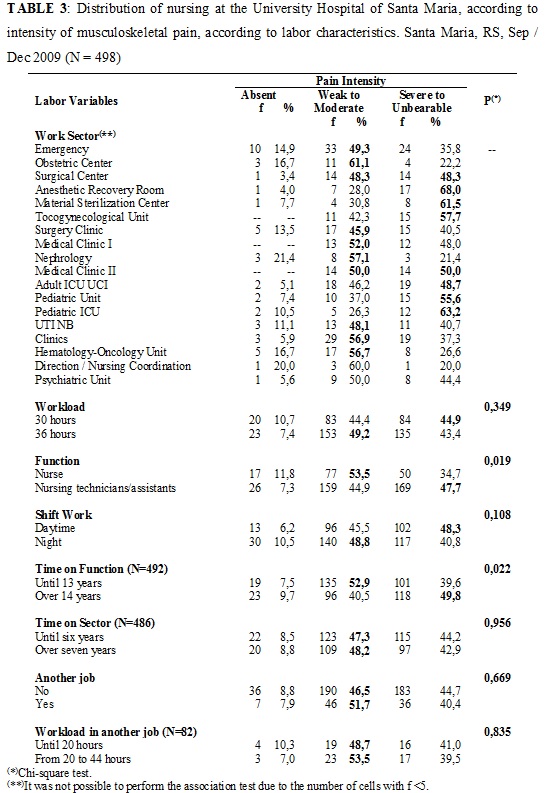
RESEARCH ARTICLES
Factors associated with musculoskeletal pain in hospital nursing workers
Ana Cláudia Soares de LimaI; Tânia Solange Bosi de Souza MagnagoII; Andrea ProchnowIII; Marinez Diniz da Silva CeronIV ; Ana Cecília SchardongV ; Camila de Brum ScalconVI
INurse. Master student on Post Graduate Program in Nursing, Federal University of Santa Maria. Porto Alegre, Rio Grande do Sul, Brasil. E-mail: anaclenf@yahoo.com.br.
|
ABSTRACT: To analyze the relationship between musculoskeletal pain, sociodemographic and labor characteristics of nursing workers from a university hospital in Rio Grande do Sul, Brazil. A cross-sectional epidemiological study, involving 498 nursing workers, conducted in 2009. For data collection, we used a questionnaire containing sociodemographic and labor data, health care professionals and analog scale of pain assessment. The prevalence of musculoskeletal pain was 91,4%, and 11,6% had low-intensity pain, 35,7% moderate pain, 39% strong pain and 5,1% unbearable pain. Women, nursing technicians and assistants and those with more than 14 years in exercising nursing, showed significantly higher percentages for strong and unbearable pain. The results indicate a positive relationship between pain and sociodemographic and labor characteristics in nursing workers and highlight the need to offer better working conditions on health services.
Keywords: Nursing; occupational health health services; musculoskeletal pain; working conditions.
INTRODUCTION
The expression “worker’s health” refers to a field of knowledge that seeks to understand the relationship between work and health/disease process. In this sense, health and the disease are considered dynamic processes, closely articulated with the production development methods of mankind in particular historical moment. It is assumed that the mode of insertion of workers in work environment contributes decisively to specific forms of illness and death1.
Among workers with illnesses, problems related to musculoskeletal pain have been detached. Musculoskeletal complaints are mentioned by workers in different age groups worldwide, evidencing an important problem in the worker’s health and public health fields1. It can manifest itself in different degrees of disability and consequently raise absenteeism, temporary or permanent absences, as well as treatment costs and indemnifications2,3.
Review study shows that the health professions, nursing in particular, show prevalence 43 to 93% of involvement in this problem4. Working in hospitals is very exhausting, the numerous comings and goings of patients with X-rays, CT scans or tests; the adoption of inappropriate postures to perform some nursing activities for lack or inadequacy of materials, furniture and equipment; overload of activities due to overcrowding and employee deficit; pressure over time; demands; constant leg pain, back pain and physical/mental tiredness - all these are causes of stress for nursing staff and often the illness and absence from work3.
Workers’ suffering can be expressed by two symptoms: dissatisfaction and anxiety, which may be linked to working conditions (physical, chemical and biological environment, material and safety conditions) and to the organization of work (division of labor, of tasks, ability to care for critically ill patients, interpersonal relationships)5.
Each of the working conditions mentioned has some impact on the ability to work, and the pain felt by workers is one of the harmful factors to their physical and mental health. So relating the pain to sociodemographic and labor characteristics of workers can provide subsidies for changes to be made, adapting the work environment in accordance with the conditions of the professionals working in it.
Thus, it is important to know the factors that favor these manifestations of pain or occurrence of injuries in nursing workers so that you can reduce them or eliminate them. This study aimed to analyze the relationship between musculoskeletal pain, sociodemographic and labor characteristics of nursing workers at a university hospital in Rio Grande do Sul, Brazil.
LITERATURE REVIEW
Musculoskeletal pain is part of a set of signs and symptoms (pain, numbness, heaviness, fatigue, limitation of movement and inability to work) that may appear concurrently or not and determine the Work-Related Musculoskeletal Disorders (RSLs / WRMD)6. These are not a new problem. The topic has been debated not only by health experts, but also by social, social security and policy experts, since 1990, aiming to find strategies to minimize their effects on workers' health7. However, all efforts seem to have not been enough, because the prevalence of these disorders remains in several professions.
Due to the multi-causality of factors, diagnosis of the etiology of musculoskeletal disorders is not easy to do in most individuals. Study8 discussed some propositions on the relationship between stress, psychosocial work factors and the occurrence of these disorders, concluding that stress and work psychosocial aspects are important risk factors to be identified and understood in the workplace. They should be considered in analyzes that aim to build healthier workplaces8:118.
Chances of success in healing of WMSDs are as higher as are earlier diagnosis and initiation of appropriate treatment. On the other hand, the severity of the problem is directly related to the time evolution of the clinical picture6.
METODOLOGY
This is an epidemiological study, approved by the Federal University of Santa Maria Research Ethics Committee - UFSM / RS (CAAE n. 0070.0.243.000-09), in June 2009. Professionals who agreed to participate voluntarily in the study signed the Informed Consent Form (ICF). The ethical aspects were ensured in the rules of Resolution 196/96 valid during the study period.
The study population was 634 nursing staff (nurses, technicians and nursing assistants) of University Hospital of Santa Maria (HUSM). Inclusion criteria: all employees of nursing professionals who have developed their activities in the hospital. Exclusion criteria: active workers in other nursing units (out of HUSM), who were on vacation, leave or absence from work during the data collection period.
Data collection was performed by 22 collectors (nursing students and nurses from the research institution) previously trained by the project coordinator. It was conducted in the period from September to December 2009, during work shifts (morning, afternoon and evening) of the nursing staff. We used a survey instrument containing closed questions on sociodemographic data (age, sex, education, marital status and skin color), labor (labor sector, workload, function, shift work, amount of time on function in the sector, another job and workload in another job) and musculoskeletal pain.
To evaluate the reports of musculoskeletal pain perceived in the last week, we used the numerical pain scale9. The score ranges from zero to 10, where zero is the total absence of pain and 10 the most severe pain already perceived by the subject. For the analyzes, the level of pain was characterized: absent, weak to moderate pain, severe to unbearable pain. Other characteristics were analyzed: age, sex, education, marital status, race, sector, function, amount of time on function and sector, shift, weekly working hours, and workload in another job.
Data were entered into a spreadsheet. For this, we used the Epi Info® program, version 6.4, with dual independent typing. After checking for errors and inconsistencies, data analysis was performed in PASW Statistics (Predictive Analytics Software, da SPSS Inc., Chicago - USA) program, version 18.0 for Windows.
Initially, a descriptive analysis of the variables (measures of central tendency and proportions) was carried out. Subsequently, a bivariate analysis was applied, testing the association between the degree of musculoskeletal pain and the independent variables (sociodemographic and labor variables), by Chi-square, adopting a significance level of 5% (p <0 05).
RESULT
Of the total population (N = 634), 42 nursing workers performed their functions in other sectors of the university (Veterinary Hospital, Dental Service) or were on absence during the data collection. Thus, 592 workers were eligible for the study. Of these, 498 (84%) workers answered the questionnaire. Losses 94 (16%) resulted from refusals to participate in the research.
It was observed predominance of female sex workers 437 (87.8%); 163 (32.7%) aged between 47 and 69 years old, mean age 41,3 years old (± 8.9), minimum of 24 and maximum of 69 years old. The most repeated age was 47 years old. 345 (69.3%) were married or living together, 180 had completed high school (36.1%), and 425 (85.3%) reported being white. Of workers, 144 (28.9%) were nurses, 222 (44.6%) nursing technicians and 132 (26.5%) nursing assistants; 199 (40%) work the night shift and 311 (62.4%) carry a workload of 36 hours per week.
The reporting frequency and the intensity of musculoskeletal pain is described in Table 1.

The prevalence of musculoskeletal pain was 91.4%, prevailing reports of severe pain 194 (39%), as shown in Table 1.
The reporting frequency and the intensity of musculoskeletal pain and its relationship to sociodemographic characteristics are described in Table 2.

Female showed a higher percentage 207 (47.4%) for severe pain to unbearable when compared to male workers (p <0.001), as shown in Table 2.
The reporting frequency and the intensity of musculoskeletal pain and its relation with labor characteristics are described in Table 3.

A significant difference in reports of severe to unbearable pain between technicians and nursing assistants was observed, as well as among those with more than 14 years working in the function (p <0.05), as shown in Table 3.
DISCUSSION
The high percentage of reported musculoskeletal pain expresses the real debilitation that involves workers surveyed in regard to pain at different levels of intensity. Similar prevalence rates found in other studies confirm the relevance of this problem among nursing workers10,12. This problem etiology, pathophysiology, and treatment should be identified as priority by the scientific community, health professionals, managers and employees.
Study13, with the aim of analyzing the health problems related to the musculoskeletal system of nursing staff in 23 health institutions of Minas Gerais, showed 6,070 calls to the nursing staff, over a period of one year. Of all visits, 718 (11.8%) were diagnosed as problems related to the musculoskeletal system, involving many anatomical locations, such as spine, upper and lower limbs. Among these problems, 255 (35%) were considered RSLs/WRMD.
Early detection of factors that cause pain in workers is important to prevent consequences to come to the extreme, resulting in RSLs/WRMD or other injuries caused by unfavorable working conditions.
Studies14,15 have shown differences between gender in reporting musculoskeletal symptoms. Male gender has been shown to be a protective factor for pain itself. Confirming these study results, a research16 bout occupational factors associated with musculoskeletal pain in teachers, the prevalence of pain for the three regions studied (upper limbs, lower limbs and back / spine), was statistically associated with being female and aged ≥ 40 years old. Another study17 has found that females showed higher percentages for both the level of unbearable pain as to the reduced ability to work.
These results may be evidence of a risk category to musculoskeletal injuries. According to the World Health Organization18, aging worker is everyone aged 45 years old or older. From that age, the loss of some functional capabilities tend to be accentuated if preventive measures are not adopted, as well as working conditions are not suitable.
Modifications suffered by workers in many systems of human body may lead to a gradual decrease in the effectiveness of each one of them. Demands that once seemed not to be so heavy, with changes in the body due to aging, can become gradually elevated to the physiological conditions of the workers, thus causing decreased ability to work.
When the intensity of reported pain according to labor characteristics (Table 3) was evaluated, it was shown a significant difference between the technicians and nurses (p = 0.019) and among those with more than 14 years in the same role (p = 0.022). Nurses reported weak to moderate musculoskeletal pain intensity and technicians/assistants reported strong to unbearable intensity. The other variables showed no difference between groups. However, it is important to note that sectors: Anesthetic Recovery Room, Pediatric ICU, Central Supply and Sterilization, Tocogynecological Unit, Pediatric and Medical Clinic II had the highest percentages for severe to unbearable pain.
Study19 developed with the British population to determine the prevalence of pain in the cervical region and its relation to occupation identified that nursing was one of the professions that most reported pain, second only the construction workers.
Each professional is exposed to various occupational hazards. In nursing musculoskeletal pain may be related to body posture adopted in procedures, efforts to move and transport patients, the psychological demands from the constant state of alert, the severity of the patients, the fast pace and repetitiveness of tasks, among others, are factors that increase the physical and psychological burdens, which contribute to a situation of muscle tension. Thus, nursing experiences exposure to different demands at work, leading to physical and mental overload20.
Nursing technicians and assistants reported a greater degree of pain than the nurses intensity, perhaps expressing the realization of heavier and more repetitive activities of the function. Another study13 also highlighted the nursing assistants category with greater attendance frequency in the Division of Health Care Workers (84.6%).
These data show that the presence of health problems is more common among technicians and nursing assistants, which may be related to the type of activities developed, more directly aimed at assistance, unlike nurses who manage the care and the unit. Authors21 observed that there is a high occurrence of musculoskeletal symptoms in multiple body regions, affecting mainly the lower back, shoulders, knees and neck. Among the associated factors were the handling and transportation of patients.
The relationship between larger amount of time on the function and reports of severe to unbearable pain gives visibility to the health problems resulting from working life, exposure to diversity in nursing workloads and greater wear22.
CONCLUSION
A high percentage of musculoskeletal pain report was observed. Features like being a woman, being nursing technician or assistant and having more amount of time in function were associated with severe to unbearable pain. The other variables investigated showed no positive association with musculoskeletal pain.
Pain is disabling. Workers suffering from musculoskeletal disorders often are classified in the work environment as plaintive. However, one should take into account that, generally, the diagnosis of these disorders is clinical, once they do not exhibit external characteristics. So, it is important to consider the possibility of active and collective participation of workers in struggle for better working conditions as a priority.
Likewise, it is very important that managers pay attention to the results found in this and other researches, for while working conditions are not improved, complaints of musculoskeletal pain will be difficult to be resolved.
One limitation of this study was the exclusion of workers on absence for health care (bias of the healthy worker effect). Furthermore, it is noted that the cross-sectional studies do not guarantee the temporality (cause-effect). Thus, further research with other designs is recommended, in order to understand in greater depth the relationship evidenced here.
REFERENCES
1. Ministério da Saúde (Br). Departamento de Atenção Básica. Área Técnica de Saúde do Trabalhador. Caderno de saúde do trabalhador. Brasília (DF): Ministério da Saúde; 2001.
2. Magnago TSBS, Lisboa MTL, Griep RH, Kirchhof ALC, Camponogara S, Nonnenmacher CQ, et al. Condições de trabalho, características sociodemográficas e distúrbios musculoesqueléticos em trabalhadores de enfermagem. Acta Paul Enferm. 2010;23:187-93.
3. Magnago TSBS, Lisboa MTL, Griep RH, Kirchhof ALC, Guido LA. Psychosocial aspects of work and musculoskeletal disorders in nursing workers. Rev Latino-Am Enfermagem. 2010;18:429-35.
4. Magnago TSBS, Lisboa MTL, Souza IEO, Moreira MC. Distúrbios músculo-esqueléticos em trabalhadores de enfermagem: associação com condições de trabalho [revisão]. Rev Bras Enferm. 2007;60:701-5.
5. Dejours CA. Loucura do trabalho: estudo da psicopatologia do trabalho. 5a ed. São Paulo: Cortez; 1992.
6. Ministério da Saúde (Br). Instrução normativa INSS/DC n° 98. Brasília (DF): Ministério da Saúde; 2003.
7. Magalhães NAC, Farias SNP, Mauro MYC, Donato MD, Domingos AM. O absenteísmo entre trabalhadores de enfermagem no contexto hospitalar. Rev enferm UERJ. 2011; 19:224-30.
8. Magnago TSBS, Lisboa MTL, Griep RH. Estresse, aspectos psicossociais do trabalho e distúrbios musculoesqueléticos em trabalhadores de enfermagem. Rev enferm UERJ. 2009; 17:118-23.
9. Jensen MP, Karoly P, Braver S. The measurement of clinical pain intensity: a comparison of six methods. Pain. 1986; 27(1):117-26.
10. Andrade CB, Monteiro MI. Envelhecimento e capacidade para o trabalho dos trabalhadores de higiene e limpeza hospitalar. Rev esc enferm USP. 2007; 41:237-44.
11. Duran ECM, Cocco MIM. Capacidade para o trabalho entre trabalhadores de enfermagem do pronto-socorro de um hospital universitário. Rev Latino-Am Enfermagem. 2004; 12:43-9.
12. Raffone AM, Hennington EA. Avaliação da capacidade funcional dos trabalhadores de enfermagem. Rev Saude Publica. 2005; 39:669-76.
13. Murofuse NT, Marziale MHP. Doenças do sistema osteomuscular em trabalhadores de enfermagem. Rev Latino-Am Enfermagem. 2005; 13:364-73.
14. Hooftman WE, Van Der Beek A J, Bongers PM, Van Mechelen W. Is there a gender difference in the effect of work-related physical and psychosocial risk factors on musculoskeletal symptoms and related sickness absence? Scand J Work Environ Health. 2009; 35:85-95.
15. Herin F, Paris C, Levant A, Vignaud MC, Sobaszek A, Soulat JM. Links between nurses’ organisational work environment and upper limb musculoskeletal symptoms: Independently of effort–reward imbalance. Pain. 2011;152: 2006-15.
16. Ribeiro IQB, Araújo TM, Carvalho FM, Porto LA, Reis EJFB. Fatores ocupacionais associados à dor músculo-esquelética em professores. Revista Baiana de Saúde Pública. 2011; 35:42-64.
17. Magnago TSBS, Beck CLC, Greco PBT, Tavares JP, Prochnow A, Silva RM. Avaliação da capacidade para o trabalho dos trabalhadores de enfermagem de pronto-socorro. Rev Eletr Enf. 2013; 15:523-32.
18. Organização Mundial de Saúde (OMS). Global strategy on occupational health for all: the way to health at work. Recommendation of the second meeting of the WHO Collaborating Centers in Occupational Health. Beijing (China): 1994.
19. Palmer KT, Walker-Bone K, Griffin MJ, Syddall H, Pannett B, Coggon D. Prevalence and occupational associations of neck pain in the British population. Scand J Work Environ Health. 2001; 27(1):49-56.
20. Magnago TSBS, Lima ACS, Prochnow A, Ceron MDS,Tavares JP, Urbanetto JS. Intensity of musculoskeletal pain and (in) ability to work in nursing. Rev Latino-Am Enfermagem. 2012; 20:1125-33.
21. Gurgeira GP, Alexandre NMC, Corrêa HP Filho. Prevalência de sintomas músculo-esqueléticos em trabalhadoras de enfermagem. Rev Latino-Am Enfermagem. 2003;11: 608-13.
22. Sápia T, Felli VEA, Ciampone MHT. Health problems among outpatient nursing personnel with a high physiological workload. Acta Paul Enferm. 2009; 22:808-13.